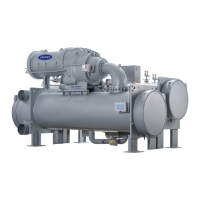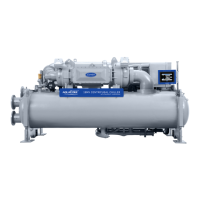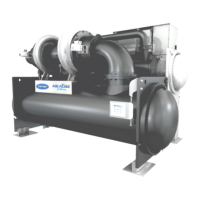50
3. Access the PRESSURE or (if water side pressure)
HYDRAULIC STATUS screen and view the particu-
lar transducer reading. To calibrate pressure or water-
side flow device, view the particular reading. It
should read 0 psig (0 kPa). If the reading is not 0 psig
(0 kPa), but within ± 5 psig (35 kPa), the value may
be set to zero from the Maintenance Menu while the
appropriate transducer parameter is highlighted. The
value will now go to zero.
If the transducer value is not within the calibration range,
the transducer returns to the original reading. If the pressure
is within the allowed range (noted above), check the volt-
age ratio of the transducer. To obtain the voltage ratio, di-
vide the voltage (dc) input from the transducer by the sup-
ply voltage signal or measure across the positive (+ red)
and negative (– black) leads of the transducer. The input to
reference voltage ratio must be between 0.80 and 0.11 for
the software to allow calibration. Rotate the waterside flow
pressure device from the inlet nozzle to the outlet nozzle
and repeat this step. If rotating the waterside flow device
does not allow calibration, pressurize the transducer until
the ratio is within range. Then attempt calibration again.
4. Installation of pressure transducers into water nozzles
using flushable dirt leg trap is suggested; see Fig. 45.
Pressures can be calibrated between 100 and 250 psig
(689.5 and 1723.7 kPa) by attaching a regulated 250 psig
(1724 kPa) pressure (usually from a nitrogen cylinder).
For calibration, access the Pressure Sensor Calibration
Menu from the Maintenance Menu and calibrate the ap-
propriate sensor.
The PIC5 control system does not allow calibration if the
transducer is too far out of calibration. In this case, a new trans-
ducer must be installed and re-calibrated.
High Altitude Locations — Because the chiller is ini-
tially calibrated at sea level, it is necessary to recalibrate the
pressure transducers if the chiller has been moved to a high
altitude location. Note that Atmospheric Pressure can be ad-
justed in the Service Parameters Menu (located in the Config-
uration Menu).
Quick Test — The Quick Test feature is located in the Main
Menu. Use this feature to test chiller status, test the status of vari-
ous actuators, view water temperature deltas, and test pump and
relays, as well as control inlet guide vane, EC valve, alarms, con-
denser, and chilled water pumps. The tests can help to determine
whether a switch is defective or a pump relay is not operating, as
well as other useful troubleshooting issues. During pumpdown
operations, the pumps are energized to prevent freeze-up and the
vessel pressures and temperatures are displayed.
Quick Calibration — Use this menu to calibrate IGVs
and the EC valve if it has feedback.
Pumpdown/Lockout — The Pumpdown/Lockout fea-
ture, available from the Maintenance Menu, prevents compres-
sor start-up when there is no refrigerant in the chiller or if the
vessels are isolated. The Terminate Lockout feature ends the
Pumpdown/Lockout after the pumpdown procedure is reversed
and refrigerant is added.
Physical Data — Tables 18-26 and Fig. 46-58 provide
additional information on component weights, compressor fits
and clearances, physical and electrical data, and wiring sche-
matics for the operator’s convenience during troubleshooting.
Fig. 45 — Suggested Installation of Pressure Transducers into Water Nozzles Using Flushable Dirt Leg Trap
SCHRADER VALVE
1
/
4
NPTF TEE, BRASS
BALL VALVE
TWO (2) 2” PIPE NIPPLES
1
/
4
- 18 NPT
WATERBOX
NOZZLE

